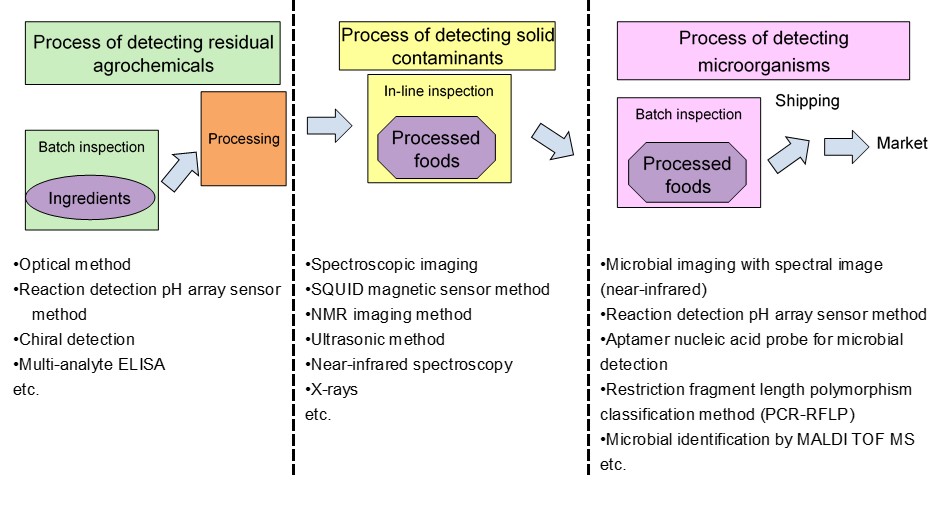
ここからコンテンツです。

Preface of the Special Issue
Toyohashi University of Technology leads the development of technologies for “Food Security and Safety” By Saburo Tanaka
At Toyohashi University of Technology (TUT), I had been leading the development of a metallic contaminant detector using a high-sensitivity magnetic sensor since 2000, and we had the accumulation of ten years of technical expertise in food contaminant detection. Professors Seiji Iwasa, Mitsuo Fukuda, Naohiro Hozumi, and Shigeki Nakauchi also had the core “seeds” for the research of biological, near-infrared, ultrasonic, and optical analysis methods, respectively. By drawing on these seeds and accumulated expertise, TUT began to consider a project proposal in collaboration with other universities and public research institutes. At that time, the Aichi prefectural government was inviting applications for funding categorized as “The Knowledge Hub Aichi Priority Research Projects”( http://www.chinokyoten.pref.aichi.jp/english/outline/). These projects would run for five years from fiscal 2011, and be large-scale projects with an annual research cost of 300 to 400 million yen for each project. Accordingly, we put together a proposal for the “Food Security and Safety Technology Development Project”, and applied. Having been successfully selected by the prefectural government, this project was launched.
Being accorded the privilege of heading the project as its leader, it was my responsibility to oversee the carrying out of research in participation with another 10 universities, 5 public research institutes and 12 companies. As shown in the figure below, the Project set its goal as being the development of systems that can detect three types of contaminants with high accuracy, high speed and at a low cost:
- detection of chemical substances such as residual agrochemicals
- detection of solid contaminants such as hairs or metals, and
- detection of microorganisms such as O157
Many companies joined along the way, and in the final year of the Project, a total of 36 companies were participating in it; 16 companies developed prototypes and 20 companies (user companies) contributed information, thereby re-classifying it as a mega project. This project consisted of goal-oriented, or “Pasteur-type” research, which aimed for commercialization based on the needs of society, and we were required to yield definite results. As it turned out, the project successfully concluded with numerous positive results: 31 prototypes, 8 commercialized products, 4 soon-to-be-commercialized products and 14 products to be made commercially available within the next two to three years
Each technology TUT contributed is described hereafter by the development leader:
- Prof. Seiji Iwasa: Detection of toxic chemical substances using immunoassay
- Prof. Mitsuo Fukuda: Contaminant detection technology using near-infrared (NIR)
- Prof. Saburo Tanaka: Contaminant detection technology using superconducting quantum interference devices (SQUIDs)
- Prof. Naohiro Hozumi: Contaminant detection technology using ultrasound
- Prof. Shigeki Nakauchi: Development of a high-sensitivity sensor device for microbial detection

All research listed in this Research Highlights was supported by the Aichi Science & Technology Foundation.
豊橋技術科学大学の総合技術力で 「食の安心と安全」をリード
豊橋技術科学大学では2000年から、環境・生命工学系の田中三郎教授が中心となって高感度磁気センサを用いた金属異物検査装置の開発を進めてきており、食品異物検査には10年の技術的蓄積がありました。また、食の安心と安全に貢献する各種技術として、バイオ手法では岩佐教授、近赤外光技術では福田教授、超音波技術では穗積教授、光学的分析技術では中内教授らが、それぞれ核となるシーズを持っていました。
愛知県が2011年から5年間の「知の拠点あいち」重点研究プロジェクト事業の募集を行った際に、これらの技術の蓄積をもとに、豊橋技術科学大学が中心となり、他大学や公的研究所と共に、「食の安心・安全技術開発プロジェクト」として取りまとめた提案が採択されました。これは、1プロジェクト当たり年間3〜4億円の大型予算の事業です。
「食の安心・安全技術開発プロジェクトでは」、田中三郎教授がプロジェクトリーダーとなり、他10大学、公的研究所5機関、企業12社が参加して研究を推進しました。目標は図に示すように、
- 残留農薬に代表される「化学物質検出」
- 髪の毛や金属異物に代表される「固形異物検出」
- O-157など食中毒菌に代表される「微生物検出」
の3つを高精度・迅速・安価で行うことができるシステムの開発としました。開発途中で多くの企業がプロジェクトに参加し、最終年度には試作企業16社、情報提供(ユーザ)企業20社で合計36社がプロジェクトに参画する超大型プロジェクトとなりました。本プロジェクトは社会ニーズに基づいた産業化を目指した出口重視の(パスツール型)研究で、確実な成果が求められており、最終的に31件の試作品ができ、製品数は8件、製品間近は4件、2-3年以内に販売できるものが14件と多くの成果を出し成功裏に終えることができました。
以下、豊橋技術科学大学で本プロジェクトの中心となった研究とその成果を紹介致します。
- 「イムノクロマト法による残留農薬の検出」 岩佐精二 環境・生命工学系教授
- 「近赤外光(NIR)を利用した実時間異物検査技術」 福田光男 機械工学系教授
- 「超伝導量子干渉素子(SQUIDs)を利用した異物検査技術」 田中三郎 環境・生命工学系教授
- 「超音波を利用した異物検査技術」 穂積直裕 電気・電子情報系教授
- 「微生物検出のための高感度センサデバイスの開発」 中内茂樹 情報・知能工学系教授
ここでコンテンツ終わりです。
